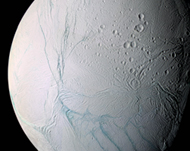Water spotted on Saturn’s moon
Speculation that life may exist beyond earth has been raised after liquid water was spotted spewing from geysers on one of Saturn’s icy moons.

Images taken by the orbiting Cassini spacecraft of the moon, Enceladus, represent some of the most direct and dramatic evidence yet of water existing in the solar system outside Earth.
Previous claims have been mostly circumstantial, based on scientists’ analysis of rocks and other indirect data.
Some scientists say that due to the findings, published in the journal Science on Friday, Enceladus should be added to the short list of places within the solar system most likely to have extraterrestrial life.
The high-resolution images from Cassini confirmed the eruption of icy jets and giant water vapour plumes from geysers at Enceladus’ south pole.
Essential ingredients
According to Carolyn Porco, a Cassini imaging scientist from the Space Science Institute in Boulder, Colorado, the pictures are the “smoking gun” that proves the existence of water.
Scientists say that if Enceladus does harbour life, it probably consists of microbes or other primitive organisms capable of living in extreme conditions.
David Morrison, a senior scientist at Nasa’s Astrobiology Institute, urged caution against judging whether the tiny moon could support life.
Scientists generally agree habitats need several ingredients for life to emerge, including water, a stable heat source and the right chemical recipe.
“It’s certainly interesting, but I don’t see how much more you can say beyond that,” Morrison said.
Scientists believe Mars and Jupiter’s icy moons might have – or once had – conditions hospitable to life.
 |
|
Cassini is due to fly near |
But the evidence is indirect. In the case of Mars, scientists have never seen any flowing water. But based on their study of rocks, they believe water once existed there.
They say magnetic readings of Jupiter’s moon Europa strongly suggest that it has an ocean of liquid water, covered by ice.
Saturn is around 1.3 billion km from Earth. Enceladus measures 505km across and is the shiniest object in the solar system.
Not so hot-spot
Enceladus was long thought to be cold and still, in part because it receives so little sunlight. But scientists now believe it is a geologically active moon that possesses an unusually warm south pole and a significant atmosphere.
The south pole “hot spot” is still chilly by Earth standards. The temperature there is -183 Celsius, which is about 20 degrees warmer than the neighbouring region.
The water is believed to come from highly pressurised underground reservoirs. Porco said the venting had probably been going on for at least several thousand years, which indicates that there is a lasting heat source underground.
Cassini found the geysers to be mostly made up of water and ice particles with significant amounts of carbon dioxide and trace amounts of methane, all of which probably help to replenish the moon’s atmosphere.
The Cassini-Huygens mission is a joint Nasa-European Space Agency project. The spacecraft was launched in 1997 and went into orbit around Saturn in 2004.
Cassini made three flybys of Enceladus last year and is expected to fly within 352km of the moon again in 2008.